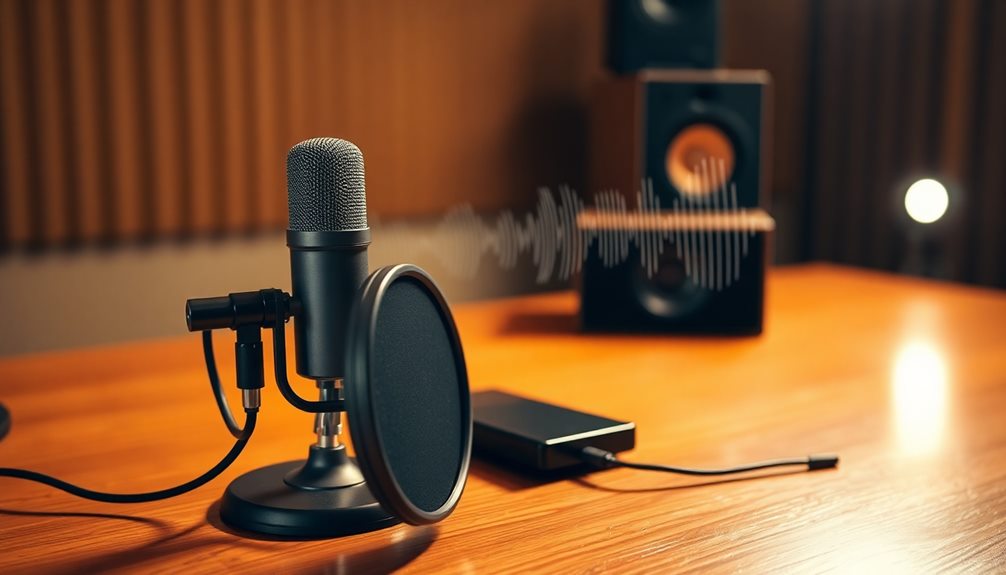So, you're dreaming of serenading someone special with a heart-melting tune? Here's our 5-step secret sauce: Pick a song title filled with meaning and love essence. Pour your soul into heartfelt lyrics sharing cherished memories. Build your song like a boss with catchy verses and a chorus that sticks. Spice it up with melody and chords that hit all the feels. Blend it perfectly for a dedication they'll never forget. Keen to uncover the magic behind each step? Let's immerse ourselves in the juiciest details of making your musical love potion irresistible.
Key Takeaways
- Choose a meaningful song title that captures the essence of your love story.
- Write heartfelt and personal lyrics infused with shared memories and emotions.
- Structure the song effectively with distinct sections like verses, chorus, and bridge.
- Craft a catchy chorus with repetition, comparisons, and clever rhyme schemes.
- Harmonize melody, chords, and lyrics to strike the right balance for a compelling dedication.
Choose a Meaningful Song Title
When selecting a meaningful song title to dedicate to someone special, consider the sentimental value it holds in your relationship. Choosing the right title is like finding the perfect gift for Valentine's Day – it's all about capturing the essence of your love in a few words.
Opt for a title that stirs up those warm, fuzzy feelings and brings back sweet memories shared between you and your special someone. Think of it as the soundtrack to your love story, with each lyric resonating the emotions you feel.
The song title you dedicate should speak volumes about your bond, expressing what words sometimes can't quite capture. So, take your time, listen to the melodies that tug at your heartstrings, and find that one title that screams 'This is us!' because when it comes to dedicating a song, the title is your love letter in disguise.
Write Heartfelt and Personal Lyrics

Let's pour our hearts into crafting lyrics that truly resonate with the special person we're dedicating this song to. When writing a love song, it's important to infuse it with personally identifying information that speaks directly to your special someone. Dive deep into your memories together and extract those golden nuggets that will make your special someone's heart flutter. Maybe it's the way they smile when they talk about their passions or the sparkle in their eyes when they laugh uncontrollably.
To make the lyrics truly heartfelt, consider the special moments you've shared and the unique bond you both cherish. Use words that tug at the heartstrings and evoke those warm, fuzzy feelings that define your relationship. Whether you opt for a romantic tone, a nostalgic vibe, or simply aim for sincerity, make sure that every word you pen down reflects the depth of your emotions. Authenticity is key when creating a dedication that will leave a lasting impact. So, let your creativity flow and pour all your love into those lyrics!
Structure the Song Effectively
To create a well-structured song, organize it into distinct sections like verses, chorus, and bridge for a cohesive and engaging musical journey. Think of it as a roadmap for your listeners, guiding them through your musical story with clear signposts. By using different sections, you keep things interesting and prevent your song from sounding like the never-ending story (unless that's your vibe, no judgment!).
Imagine your song as a rollercoaster of emotions, taking your audience on a thrilling ride with highs, lows, and unexpected turns.
When it comes to structuring your song, make sure to pay attention to the connections between sections. These are like the magical portals that transport your listeners from one part of the song to another. Use them wisely to maintain their interest and keep them hooked from start to finish.
And hey, don't forget that a well-structured song can be the perfect addition to your personal playlist or even a heartfelt gift for someone special on Valentine's Day. So, go ahead, let your creativity flow, and start structuring that musical masterpiece!
Craft a Catchy Chorus

Crafting a catchy chorus involves skillfully integrating repetition, comparisons, consistency, rhyme schemes, and variations to enhance the overall impact and appeal of the song. When creating that hook that's going to have everyone singing along, you want to make sure it's not just catchy but also meaningful. Let's break it down in a fun table below:
| Element | Description |
|---|---|
| Repetition | Repeating the song title or a key phrase can make it stick in people's minds |
| Comparisons | Drawing comparisons in the chorus can add depth and vivid imagery |
| Consistency | Keeping a consistent theme and tone throughout the chorus is essential |
| Rhyme Schemes | Crafting clever rhyme schemes can make the chorus flow smoothly |
| Variations | Adding variations in repetition within the chorus keeps it interesting |
Crafting a chorus that resonates with the audience, whether it's to dedicate to someone special or to hear someone on the radio, is the perfect way to say what's on your mind and share your opinion with the world. So, don't be afraid to get creative and submit any information you think will make your chorus stand out!
Harmonize Melody, Chords, and Lyrics
Successfully harmonizing melody, chords, and lyrics is essential in creating a compelling and engaging song dedication. When crafting a musical dedication, it's vital to strike the right balance between these elements to convey the intended emotional tone.
Here's how you can harmonize melody, chords, and lyrics effectively:
- Melody Sets the Mood: The melody is like the emotional backbone of the song. It captures the sentiment you want to express, whether it's love, nostalgia, or joy. Choosing the right notes and rhythm can evoke powerful feelings in your listener.
- Chords Provide Harmony: Just like a good support system, chords complement the melody by adding depth and richness to the music. They help create a cohesive and pleasing sound that enhances the overall emotional impact of the dedication.
- Lyrics Tell the Story: Lyrics are the storytellers of your dedication. They convey the message and meaning behind the music, allowing you to connect with your audience on a personal level. Crafting heartfelt and meaningful lyrics can truly make your dedication unforgettable.
Frequently Asked Questions
How Do You Dedicate a Song to Someone?
To dedicate a song to someone, simply call the dedicated voicemail box at YourClassical and leave a message with the recipient's name, your name, and the classical music piece you want to dedicate. Requests are open until 12 p.m. Central on Feb. 13 for the Romance stream on Feb. 14.
Stay tuned for updates by signing up for an email reminder after making your dedication. It's that easy to spread some musical love!
How Do You Dedicate a Song to Someone's Caption?
Well, dedicating a song to someone's caption is like pairing a fine wine with the perfect cheese – it's all about enhancing the flavor!
When you dedicate a song to someone's caption, you're adding a touch of musical magic to their words, turning a simple post into a heartfelt melody.
It's a creative way to show you're tuning into not just what they say, but how they say it.
How Do You Dedicate a Song to Someone on the Radio?
Oh, dedicating a song to someone special on the radio is as easy as pie! Just give the YourClassical hotline a ring at 651-290-1296 before 12 p.m. Central time on Feb. 13. For all you international folks, dial +1 651 290-1296.
Your dedication will be featured on the Romance stream on Feb. 14. Remember, your privacy is safe, and regular phone rates apply. Time to spread the love through music!
What Does Dedicate a Song to Someone Mean?
Dedicating a song to someone means expressing deep feelings and sentiments through music. It's like wrapping your emotions in melodies and sending them straight to the heart of your special person. This gesture carries a powerful message, creating a unique bond and sharing a moment that resonates with both of you.
It's a beautiful way to show love, appreciation, and connection in a romantic and heartfelt manner.
Conclusion
So there you have it, folks! Follow these 5 steps to dedicate a song to that special someone in your life and watch the magic unfold.
With a meaningful song title, heartfelt lyrics, effective structure, a catchy chorus, and harmonized melody, chords, and lyrics, you'll create a musical masterpiece that will surely touch their heart.
Give it a try and see the power of music in expressing your emotions!










